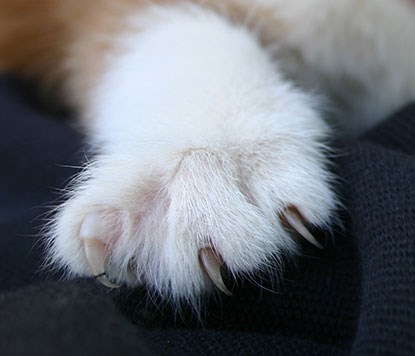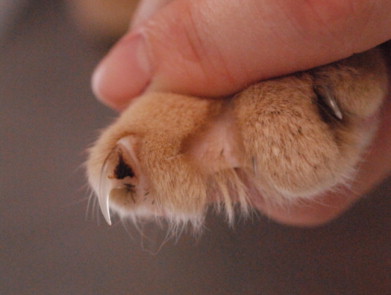Cat claws are one of the most important parts of a cat’s anatomy. Not only do they help the cat climb and scratch, but they also protect the cat from predators.
However, sometimes the claws can get too long and start to darken under the nails. This is called “darkening under cat claws” and it can be a serious problem for new cat owners.
So, what exactly causes it and what can you do about it? Let’s find out…
Why is under my cat’s nails black?
The medical term for this condition is onychodystrophy and it can be caused by a few different things.
The most common cause is simply an overgrowth of the nails. This can happen when the cat doesn’t have enough opportunities to scratch, either because they don’t have access to a scratching post or because they’re declawed.
In these cases, the nails will continue to grow and can eventually start to curve under the footpads. This can cause pain and discomfort for the cat, as well as make it difficult for them to walk.
Another possible cause of onychodystrophy is an infection. If the nails are not trimmed properly or if the cat has an injury to the nails, bacteria can enter and cause an infection. This can lead to swelling, redness, and eventually darkening of the nails.
If not treated quickly, the infection can spread to the rest of the body and become very dangerous.
It is also possible for your cat’s nails to turn black from a rare autoimmune disease. This is a condition where the body’s immune system attacks the nails for unknown reasons.
Autoimmune nail disease can cause the nails to become thick, brittle, and discolored. In severe cases, the nails may fall off completely.
Lastly, onychodystrophy can be caused by a nutritional deficiency. If the cat isn’t getting enough of certain vitamins and minerals, it can affect the nails.
This is most common in kittens and older cats, as they are more likely to be deficient in these nutrients.
What Color Should My Under Cats Claws Be?

Under normal circumstances, your kitty’s nails should be a pale pink color.
If they start to darken, it’s a sign that something is wrong. The nails may turn yellow, brown, or black. In severe cases, the nails may fall off entirely.
If you notice that your cat’s nails are starting to darken, it’s important to take them to the vet right away.
The vet will be able to determine the cause of the problem and prescribe the appropriate treatment.
In most cases, the nails can be trimmed and the infection can be treated with antibiotics.
However, if the problem is caused by a nutritional deficiency, you may need to change your cat’s diet or give them supplements.
How Do You Tell If Your Cat’s Nails Are Infected?
Knowing whether or not the discoloration of the cat’s nail is a result of an infection can help you know how best to take care of your feline friend.
The most obvious symptom of onychodystrophy is the darkening of the nails. However, other symptoms can be associated with this condition.
If the nails are red, swollen, or painful, there is likely an infection. You may also notice that the cat is licking their paws more than usual.
If the infection spreads to the rest of the body, the cat may have a fever, lethargy, and lack of appetite.
If you notice any of these symptoms, it’s important to take your cat to the vet right away.
Why Does My Cat Have Brown Stuff On His Claws?

Your cat can develop brownish discoloration on their claws for all manner of reasons including infections and accumulation of dirt and debris.
If your cat spends time outdoors, they can easily play with dirt and thereby discolor their nails and paws.
But if the brownish color is waxy, then you might have an infection to deal with.
The brown stuff may be pus or blood from a fungal infection at the base of the nail.
There could be any number of causes of such an infection but the best course of action is to take your feline friend to the vet.
How Is Darkening Under Cat Claws Treated?
The treatment for onychodystrophy will vary depending on the cause of the problem.
If the problem is caused by an overgrowth of nails, the vet will simply trim them back.
If the problem is caused by an infection, the vet will prescribe antibiotics.
In most cases, this will clear up the infection and the nails will return to their normal color.
However, if the problem is caused by a nutritional deficiency, you may need to change your cat’s diet or give them supplements.
Prevention is the best medicine when it comes to onychodystrophy. The first way to prevent this condition is to always ensure your cat’s claws are trimmed.
If your cat doesn’t go outside, you can also consider declawing them. Additionally, you want to feed your cat a healthy and balanced diet.
Do not use a homemade recipe before you consult with a vet just to be sure your cat is getting all the required nutrients which include vitamins and minerals.
Home remedies
There are a few home remedies that you can try if your cat is dealing with onychodystrophy.
The first step is to trim the claws so that they’re not touching the ground. You can do this yourself or take your cat to a groomer.
To do it yourself, soak the affected nails in warm water for 10 minutes. This will help to soften the nails and make them easier to trim.
You can also try massaging the nails with olive oil or coconut oil. This can help to improve circulation and promote healing.
If you’re concerned about your cat’s diet, you can talk to your vet about whether or not they need vitamins or minerals.
Parting Thoughts
While most people think of cats as being low-maintenance pets, there is actually quite a bit of care that goes into keeping them healthy and happy.
For instance, cats need to have their nails trimmed regularly. If they don’t, the nails can become overgrown and start to curl under, which can be painful for the cat.
In some rare cases, the nails may even turn black. Darkening under cat claws may seem like a minor problem, but it can quickly turn into a serious issue.
If you notice your cat’s nails starting to darken, take them to the vet right away.
With proper treatment, most cats make a full recovery and don’t have any long-term problems.
You might also like…
The following are some related posts to do with cat claws:
Cat Claw Bent Sideways: What Does It Mean?
Cat Dew Claw Injury: A Quick Guide for New Cat Owners

Hi! I am Eleanor Price. I started this website after my cat, Louie, almost died from a case of botulism (a type of food poisoning often caused by bacteria that grow on food items). Turned out that my cat’s diet was the problem. I have made it my duty to provide the best information and recommendations about everything cat lovers need to know about their felines’ health and wellbeing. My goal is to find the most informative content on anything feline-related and share it with fellow hardworking kitty lovers.

